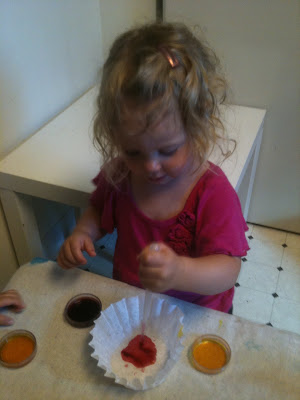Over
the last couple of weeks, we have been experimenting with color
mixing in the toddler classroom. These are the materials we used and
what we noticed:
1.
Water, Watercolors, and Droppers:
We
began our exploration of color mixing with red and blue watercolor,
using droppers to drop the watercolor into jars of tap water. We
discussed what colors were on the table. M said “red and blue.”
T, M, and watched as the drops of watercolor slowly
dispersed into the water.


When the girls were finished, we had a jar of red-colored water, one jar of blue-colored water, and two jars that were very dark looking. I took one of the jars and put it up to the light to see the color better. They observed the water for a moment, then M exclaimed, “purple!”
2.
Cornstarch, Watercolors, and Droppers:
Next
we explored watercolors in cornstarch. I again chose two primary
colors to offer Cohort 3, yellow and blue. T, M, and S
were a bit apprehensive at first. Then S dipped her dropper in
her lid filled with blue watercolor, and sprinkled the watercolor on
top of the cornstarch. T and M quickly followed. Then M poured all of her blue and yellow paint in. We observed the
cornstarch and watercolor for a moment, noticing the small hard balls
that formed where the watercolor touched the cornstarch. T and
S were then done, but M continued to experiment.
Adding
Salt and Water:
M then added salt to the cornstarch mixture, observing it closely each
time she sprinkled some in the bowl. She then began to pour a small
pitcher of water into the bowl, asking, “Can I pour all of it?”
After replying, “Yes,” she poured the rest of the water in. She
then began exploring the mixture with her hands, grabbing hard chunks
of cornstarch, watercolor, and water that formed in various places.
We discussed the texture of the mixture, noticing some of it was
runny, some was powder, and some was hard. We then talked about the
different colors in the bowl. M exclaimed, “It's green,” as
she continued to dig her fingertips into the mixture.
3. Coffee
Filters, Watercolors, and Droppers:
Our
final color mixing experiment using watercolor also included droppers
and white coffee filters. This time we used red and yellow
watercolor, placed in two separate lids for each child. S filled
up her dropper with as much red watercolor as possible, squeezing it
all out onto her coffee filter in a puddle. J also went straight
for the red watercolor, squeezing a small amount into the tip of his
dropper and releasing the watercolor onto his filter. M dipped her
dropper in the yellow watercolor, then the red watercolor before
dropping the watercolor onto her filter. T dropped a couple
drops of yellow watercolor onto her filter, then in a different spot
she dropped a few drops of red watercolor.




When
everyone was done, each child's coffee filter was different. We
talked about what we noticed about the watercolors on the coffee
filters. We talked about the colors we used and what happens when
yellow and red watercolor mix together. M noticed she had some
“orange” on her coffee filter.

Through
thoughtful exploration of color mixing with watercolors, Cohort 3 are
figuring out the scientific properties of watercolor and various
substances, they are learning about colors, including primary colors
and what happens when watercolors are mixed together, they are
strengthening their fine motor skills, and they are building their
language around colors and art materials.
Next...
Color mixing with tempura paint!!
















Comments
Post a Comment